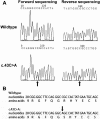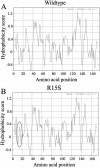A novel gammaD-crystallin mutation causes mild changes in protein properties but leads to congenital coralliform cataract
- PMID: 19668596
- PMCID: PMC2722711
A novel gammaD-crystallin mutation causes mild changes in protein properties but leads to congenital coralliform cataract
Abstract
Purpose: To identify the genetic lesions for congenital coralliform cataract.
Methods: Two Chinese families with autosomal dominant coralliform cataract, 12 affected and 14 unaffected individuals, were recruited. Fifteen known genes associated with autosomal dominant congenital cataract were screened by two-point linkage analysis with gene based single nucleotide polymorphisms and microsatellite markers. Sequence variations were identified. Recombinant FLAG-tagged wild type or mutant gammaD-crystallin was expressed in human lens epithelial cells and COS-7 cells. Protein solubility and intracellular distribution were analyzed by western blotting and immunofluorescence, respectively.
Results: A novel heterozygous change, c.43C>A (R15S) of gammaD-crystallin (CRYGD) co-segregated with coralliform cataract in one family and a known substitution, c.70C>A (P24T), in the other family. Unaffected family members and 103 unrelated control subjects did not carry these mutations. Similar to the wild type protein, R15S gammaD-crystallin was detergent soluble and was located in the cytoplasm. ProtScale and ScanProsite analyses revealed raised local hydrophobicity and the creation of a hypothetical casein kinase II phosphorylation site.
Conclusions: A novel R15S mutation caused congenital coralliform cataract in a Chinese family. R15S possessed similar properties to the wild type gammaD-crystallin, but its predicted increase of hydrophobicity and putative phosphorylation site could lead to protein aggregation, subsequently causing opacification in lens.
Figures




Similar articles
-
A novel mutation in γD-crystallin associated with autosomal dominant congenital cataract in a Chinese family.Mol Vis. 2011 Mar 26;17:804-9. Mol Vis. 2011. PMID: 21527994 Free PMC article.
-
A recurrent mutation in CRYGD is associated with autosomal dominant congenital coralliform cataract in two unrelated Chinese families.Mol Vis. 2011 Apr 28;17:1085-9. Mol Vis. 2011. PMID: 21552497 Free PMC article.
-
A novel deletion variant of gammaD-crystallin responsible for congenital nuclear cataract.Mol Vis. 2007 Nov 7;13:2096-104. Mol Vis. 2007. PMID: 18079686
-
Mutation G61C in the CRYGD gene causing autosomal dominant congenital coralliform cataracts.Mol Vis. 2008 Mar 4;14:378-86. Mol Vis. 2008. PMID: 18334953 Free PMC article.
-
Congenital coralliform cataract is the predominant consequence of a recurrent mutation in the CRYGD gene.Orphanet J Rare Dis. 2023 Jul 21;18(1):200. doi: 10.1186/s13023-023-02816-0. Orphanet J Rare Dis. 2023. PMID: 37480084 Free PMC article.
Cited by
-
A missense mutation in CRYGD linked with autosomal dominant congenital cataract of aculeiform type.Mol Cell Biochem. 2012 Sep;368(1-2):167-72. doi: 10.1007/s11010-012-1355-2. Epub 2012 Jun 6. Mol Cell Biochem. 2012. PMID: 22669729 Clinical Trial.
-
Crystal structure of the cataract-causing P23T γD-crystallin mutant.Proteins. 2013 Sep;81(9):1493-8. doi: 10.1002/prot.24321. Epub 2013 Jun 17. Proteins. 2013. PMID: 23670788 Free PMC article.
-
Coarse-grained model for colloidal protein interactions, B(22), and protein cluster formation.J Phys Chem B. 2013 Dec 19;117(50):16013-28. doi: 10.1021/jp409300j. Epub 2013 Dec 10. J Phys Chem B. 2013. PMID: 24289039 Free PMC article.
-
Association between a Tetranucleotide Repeat Polymorphism of SPAG16 Gene and Cataract in Male Children.J Biomark. 2013;2013:810395. doi: 10.1155/2013/810395. Epub 2013 Sep 27. J Biomark. 2013. PMID: 26317022 Free PMC article.
-
Inherited Congenital Cataract: A Guide to Suspect the Genetic Etiology in the Cataract Genesis.Mol Syndromol. 2017 Mar;8(2):58-78. doi: 10.1159/000455752. Epub 2017 Feb 7. Mol Syndromol. 2017. PMID: 28611546 Free PMC article. Review.
References
-
- Abrahamsson M, Magnusson G, Sjostrom A, Popovic Z, Sjostrand J. The occurrence of congenital cataract in western Sweden. Acta Ophthalmol Scand. 1999;77:578–80. - PubMed
-
- Rahi JS, Dezateux C. Measuring and interpreting the incidence of congenital ocular anomalies: lessons from a national study of congenital cataract in the UK. Invest Ophthalmol Vis Sci. 2001;42:1444–8. - PubMed
-
- Holmes JM, Leske DA, Burke JP, Hodge DO. Birth prevalence of visually significant infantile cataract in a defined U.S. population. Ophthalmic Epidemiol. 2003;10:67–74. - PubMed
Publication types
MeSH terms
Substances
LinkOut - more resources
Full Text Sources
Medical
